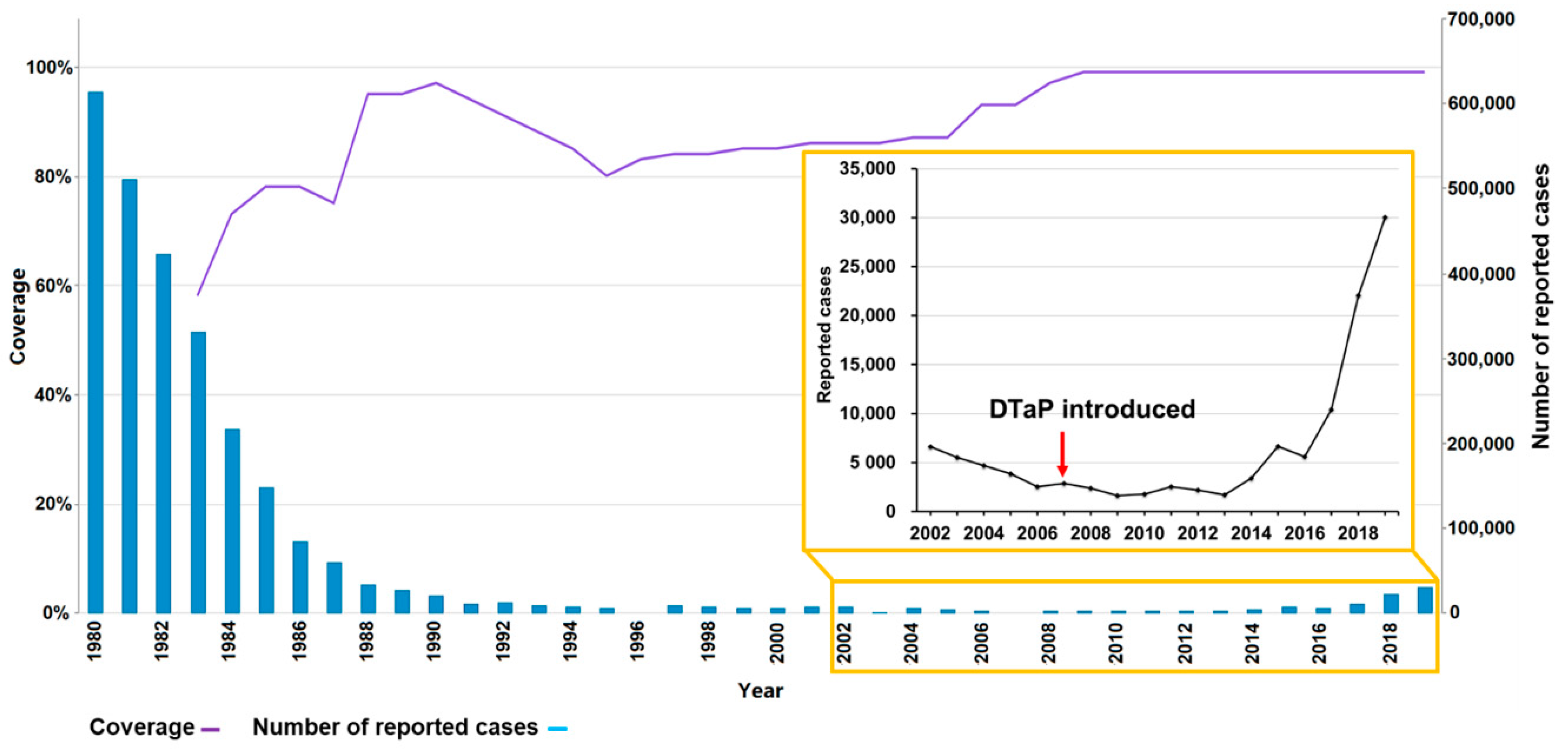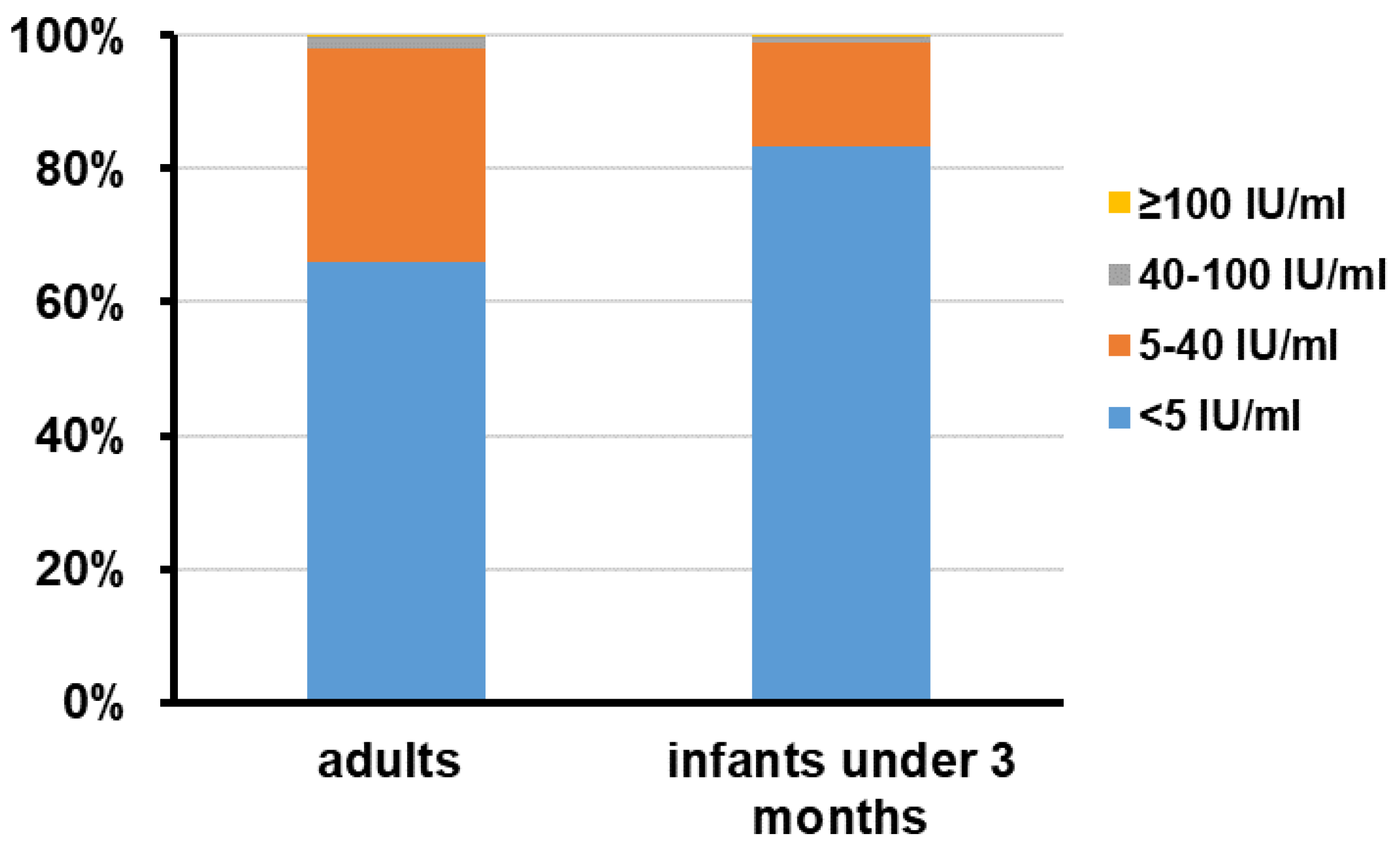Seroprevalence Study of Pertussis in Adults at Childbearing Age and Young Infants Reveals the Necessity of Booster Immunizations in Adults in China
Abstract
1. Introduction
2. Materials and Methods
2.1. Study Subjects and Serum Samples
2.2. Serological Testing
2.3. Statistical Analysis
3. Results
4. Discussion
5. Conclusions
Author Contributions
Funding
Institutional Review Board Statement
Informed Consent Statement
Data Availability Statement
Acknowledgments
Conflicts of Interest
References
- Masseria, C.; Martin, C.K.; Krishnarajah, G.; Becker, L.K.; Buikema, A.; Tan, T.Q. Incidence and Burden of Pertussis among Infants Less Than 1 Year of Age. Pediatr. Infect. Dis. J. 2017, 36, e54–e61. [Google Scholar] [CrossRef]
- World Health Organization (WHO). Immunization Data: Comparison of Immunization Coverage for DTP Vaccination Coverage and Reported Cases for Pertussis. Available online: https://immunizationdata.who.int/compare.html?COMPARISON=type1__WIISE/MT_AD_COV_LONG+type2__WIISE/MT_AD_INC_LONG+option1__DTP_coverage+option2__PERTUSSIS_cases&CODE=CHN&YEAR= (accessed on 13 September 2021).
- National Health Commission of the People’s Republic of China. Epidemic Situations of Legal Infectious Diseases in China. Available online: http://www.nhc.gov.cn/jkj/s7923/202108/7337fd75c8b749309a2de28aec1a03bd.shtml (accessed on 13 September 2021).
- Zhang, Y.; Chen, Z.; Zhao, J.; Zhang, N.; Chen, N.; Zhang, J.; Li, S.; He, Q. Increased susceptibility to pertussis in adults at childbearing age as determined by comparative seroprevalence study, China 2010–2016. J. Infect. 2019, 79, 1–6. [Google Scholar] [CrossRef]
- Skoff, T.H.; Kenyon, C.; Cocoros, N.; Liko, J.; Miller, L.; Kudishet, K.; Baumbach, J.; Zansky, S.; Faulkner, A.; Martin, S.W. Sources of Infant Pertussis Infection in the United States. Pediatrics 2015, 136, 635–641. [Google Scholar] [CrossRef] [PubMed]
- Katfy, K.; Diawara, I.; Maaloum, F.; Aziz, S.; Guiso, N.; Fellah, H.; Slaoui, B.; Zerouali, K.; Belabbes, H.; Elmdaghri, N. Pertussis in infants, in their mothers and other contacts in Casablanca, Morocco. BMC Infect. Dis. 2020, 20, 43. [Google Scholar] [CrossRef] [PubMed]
- Perrett, K.P.; Nolan, T.M. Immunization During Pregnancy: Impact on the Infant. Paediatr. Drugs 2017, 19, 313–324. [Google Scholar] [CrossRef]
- Furuta, M.; Sin, J.; Ng, E.S.W.; Wang, K. Efficacy and safety of pertussis vaccination for pregnant women—A systematic review of randomised controlled trials and observational studies. BMC Pregnancy Childbirth 2017, 17, 390. [Google Scholar] [CrossRef] [PubMed]
- Meng, Q.H.; Liu, Y.; Yu, J.Q.; Li, L.J.; Shi, W.; Shen, Y.J.; Li, L.; Zhan, S.N.; Yang, F.; Wang, Y.J.; et al. Seroprevalence of Maternal and Cord Antibodies Specific for Diphtheria, Tetanus, Pertussis, Measles, Mumps and Rubella in Shunyi, Beijing. Sci. Rep. 2018, 8, 13021. [Google Scholar] [CrossRef]
- Chen, Z.; Zhang, J.; Cao, L.; Zhang, N.; Zhu, J.; Ping, G.; Zhao, J.; Li, S.; He, Q. Seroprevalence of pertussis among adults in China where whole cell vaccines have been used for 50 years. J. Infect. 2016, 73, 38–44. [Google Scholar] [CrossRef] [PubMed]
- Godoy, P.; Garcia-Cenoz, M.; Toledo, D.; Carmona, G.; Caylà, J.A.; Alsedà, M.; Àlvarez, J.; Barrabeig, I.; Camps, N.; Plans, P.; et al. Factors influencing the spread of pertussis in households: A prospective study, Catalonia and Navarre, Spain, 2012 to 2013. Euro Surveill. 2016, 21, 30393. [Google Scholar] [CrossRef]
- Mbayei, S.A.; Faulkner, A.; Miner, C.; Edge, K.; Cruz, V.; Peña, S.A.; Kudish, K.; Coleman, J.; Pradhan, E.; Thomas, S.; et al. Severe Pertussis Infections in the United States, 2011–2015. Clin. Infect. Dis. 2019, 69, 218–226. [Google Scholar] [CrossRef]
- Fiasca, F.; Gabutti, G.; Mattei, A. Trends in Hospital Admissions for Pertussis Infection: A Nationwide Retrospective Observational Study in Italy, 2002–2016. Int. J. Environ. Res. Public Health 2019, 16, 4531. [Google Scholar] [CrossRef]
- Macina, D.; Evans, K.E. Bordetella pertussis in School-Age Children, Adolescents, and Adults: A Systematic Review of Epidemiology, Burden, and Mortality in Asia. Infect. Dis. Ther. 2021, 10, 1115–1140. [Google Scholar] [CrossRef]
- Siriyakorn, N.; Leethong, P.; Tantawichien, T.; Sripakdee, S.; Kerdsin, A.; Dejsirilert, S.; Paitoonpong, L. Adult pertussis is unrecognized public health problem in Thailand. BMC Infect. Dis. 2016, 16, 25. [Google Scholar] [CrossRef]
- Zhang, Q.; Zheng, H.; Liu, M.; Han, K.; Shu, J.; Wu, C.; Xu, N.; He, Q.; Luo, H. The Seroepidemiology of Immunoglobulin G Antibodies against Pertussis Toxin in China: A Cross Sectional Study. BMC Infect. Dis. 2012, 12, 138. [Google Scholar] [CrossRef] [PubMed]
- Li, X.; Chen, M.; Zhang, T.; Li, J.; Zeng, Y.; Lu, L. Seroepidemiology of diphtheria and pertussis in Beijing, China: A cross-sectional study. Hum. Vaccin. Immunother. 2015, 11, 2434–2439. [Google Scholar] [CrossRef] [PubMed]
- Xu, Y.; Wang, L.; Xu, J.; Wang, X.; Wei, C.; Luo, P.; Ma, X.; Hou, Q.; Wang, J. Seroprevalence of pertussis in China: Need to improve vaccination strategies. Hum. Vaccin. Immunother. 2014, 10, 192–198. [Google Scholar] [CrossRef] [PubMed][Green Version]
- Yao, N.; Zeng, Q.; Wang, Q. Seroepidemiology of diphtheria and pertussis in Chongqing, China: Serology-based evidence of Bordetella pertussis infection. Public Health 2018, 156, 60–66. [Google Scholar] [CrossRef] [PubMed]
- Healy, C.M.; Munoz, F.M.; Rench, M.A.; Halasa, N.B.; Edwards, K.M.; Baker, C.J. Prevalence of pertussis antibodies in maternal delivery, cord, and infant serum. J. Infect. Dis. 2004, 190, 335–340. [Google Scholar] [CrossRef]
- Van Savage, J.; Decker, M.D.; Edwards, K.M.; Sell, S.H.; Karzon, D.T. Natural history of pertussis antibody in the infant and effect on vaccine response. J. Infect. Dis. 1990, 161, 487–492. [Google Scholar] [CrossRef]
- Healy, C.M.; Rench, M.A.; Swaim, L.S.; Timmins, A.; Vyas, A.; Sangi-Haghpeykar, H.; Ng, N.; Rajam, G.; Havers, F.; Schiffer, J.; et al. Kinetics of maternal pertussis-specific antibodies in infants of mothers vaccinated with tetanus, diphtheria and acellular pertussis (Tdap) during pregnancy. Vaccine 2020, 38, 5955–5961. [Google Scholar] [CrossRef]
- Plans-Rubió, P. Vaccination Coverage for Routine Vaccines and Herd Immunity Levels against Measles and Pertussis in the World in 2019. Vaccines 2021, 9, 256. [Google Scholar] [CrossRef] [PubMed]
- CDC. Updated recommendations for use of tetanus toxoid, reduced diphtheria toxoid and acellular pertussis vaccine (Tdap) in pregnant women and persons who have or anticipate having close contact with an infant aged <12 months—Advisory Committee on Immunization Practices (ACIP), 2011. Morb. Mortal. Wkly. Rep. 2011, 60, 1424–1426. [Google Scholar]
- Baxter, R.; Bartlett, J.; Fireman, B.; Lewis, E.; Klein, N.P. Effectiveness of Vaccination during Pregnancy to Prevent Infant Pertussis. Pediatrics 2017, 139, e20164091. [Google Scholar] [CrossRef] [PubMed]
- Skoff, T.H.; Blain, A.E.; Watt, J.; Scherzinger, K.; McMahon, M.; Zansky, S.M.; Kudish, K.; Cieslak, P.R.; Lewis, M.; Shang, N.; et al. Impact of the US Maternal Tetanus, Diphtheria, and Acellular Pertussis Vaccination Program on Preventing Pertussis in Infants <2 Months of Age: A Case-Control Evaluation. Clin. Infect. Dis. 2017, 65, 1977–1983. [Google Scholar] [CrossRef] [PubMed]
- Halperin, S.A.; Langley, J.M.; Ye, L.; MacKinnon-Cameron, D.; Elsherif, M.; Allen, V.M.; Smith, B.; Halperin, B.A.; McNeil, S.A.; Vanderkooi, O.G.; et al. A Randomized Controlled Trial of the Safety and Immunogenicity of Tetanus, Diphtheria, and Acellular Pertussis Vaccine Immunization during Pregnancy and Subsequent Infant Immune Response. Clin. Infect. Dis. 2018, 67, 1063–1071. [Google Scholar] [CrossRef]
- Pertussis: Halting the Epidemic by Protecting Infants. Available online: http://www.bpac.org.nz/magazine/2013/march/docs/BPJ51-pages-34-38.pdf (accessed on 13 September 2021).
- Li, Y.T.; Luo, X.Q.; Zhong, X.B.; Cai, L.M.; Zhu, L.P.; Chen, X.Q.; Wang, K.C.; Chen, Z.G. Seroprevalences of antibodies against pertussis, diphtheria, tetanus, measles, mumps and rubella: A cross-sectional study in children following vaccination procedure in Guangzhou, China. Vaccine 2020, 38, 3960–3967. [Google Scholar] [CrossRef] [PubMed]



| Characteristics | Infants 1 No (%) | Adults 2 No (%) | p Value |
|---|---|---|---|
| Total | 440 | 735 | |
| Gender | |||
| Male | 222 (50.45) | 407 (55.37) | |
| Female | 218 (49.55) | 328 (44.63) | |
| Seroprevalence 3 | |||
| Total | 5 (1.14) | 15 (2.04) | 0.25 |
| Male | 3 (1.35) | 10 (2.46) | |
| Female | 2 (0.92) | 5 (1.52) | |
| Proportion of subjects with non-detectable anti-PT IgG 4 | |||
| Total | 367 (83.41) | 485 (65.99) | <0.001 |
| Male | 181 (81.53) | 264 (64.86) | |
| Female | 186 (85.32) | 221 (67.38) | |
| Anti-PT IgG concentration (IU/mL) | |||
| Geometric mean (IU/mL) | |||
| Total | 1.72 | 3.81 | |
| Male | 1.78 | 3.84 | |
| Female | 1.65 | 3.78 | |
| Median (IU/mL) | |||
| Total | 1.43 | 3.24 | |
| Male | 1.47 | 3.27 | |
| Female | 1.41 | 3.18 | |
| Range (IU/mL) | |||
| Total | 0.21–104.56 | 0.52–186.50 | |
| Male | 0.26–104.56 | 0.53–186.5 | |
| Female | 0.21–50.24 | 0.52–81.23 |
Publisher’s Note: MDPI stays neutral with regard to jurisdictional claims in published maps and institutional affiliations. |
© 2022 by the authors. Licensee MDPI, Basel, Switzerland. This article is an open access article distributed under the terms and conditions of the Creative Commons Attribution (CC BY) license (https://creativecommons.org/licenses/by/4.0/).
Share and Cite
Chen, Z.; Pang, J.; Zhang, N.; Chen, N.; Ding, Y.; He, Q. Seroprevalence Study of Pertussis in Adults at Childbearing Age and Young Infants Reveals the Necessity of Booster Immunizations in Adults in China. Vaccines 2022, 10, 84. https://doi.org/10.3390/vaccines10010084
Chen Z, Pang J, Zhang N, Chen N, Ding Y, He Q. Seroprevalence Study of Pertussis in Adults at Childbearing Age and Young Infants Reveals the Necessity of Booster Immunizations in Adults in China. Vaccines. 2022; 10(1):84. https://doi.org/10.3390/vaccines10010084
Chicago/Turabian StyleChen, Zhiyun, Jie Pang, Nan Zhang, Ning Chen, Yiwei Ding, and Qiushui He. 2022. "Seroprevalence Study of Pertussis in Adults at Childbearing Age and Young Infants Reveals the Necessity of Booster Immunizations in Adults in China" Vaccines 10, no. 1: 84. https://doi.org/10.3390/vaccines10010084
APA StyleChen, Z., Pang, J., Zhang, N., Chen, N., Ding, Y., & He, Q. (2022). Seroprevalence Study of Pertussis in Adults at Childbearing Age and Young Infants Reveals the Necessity of Booster Immunizations in Adults in China. Vaccines, 10(1), 84. https://doi.org/10.3390/vaccines10010084







